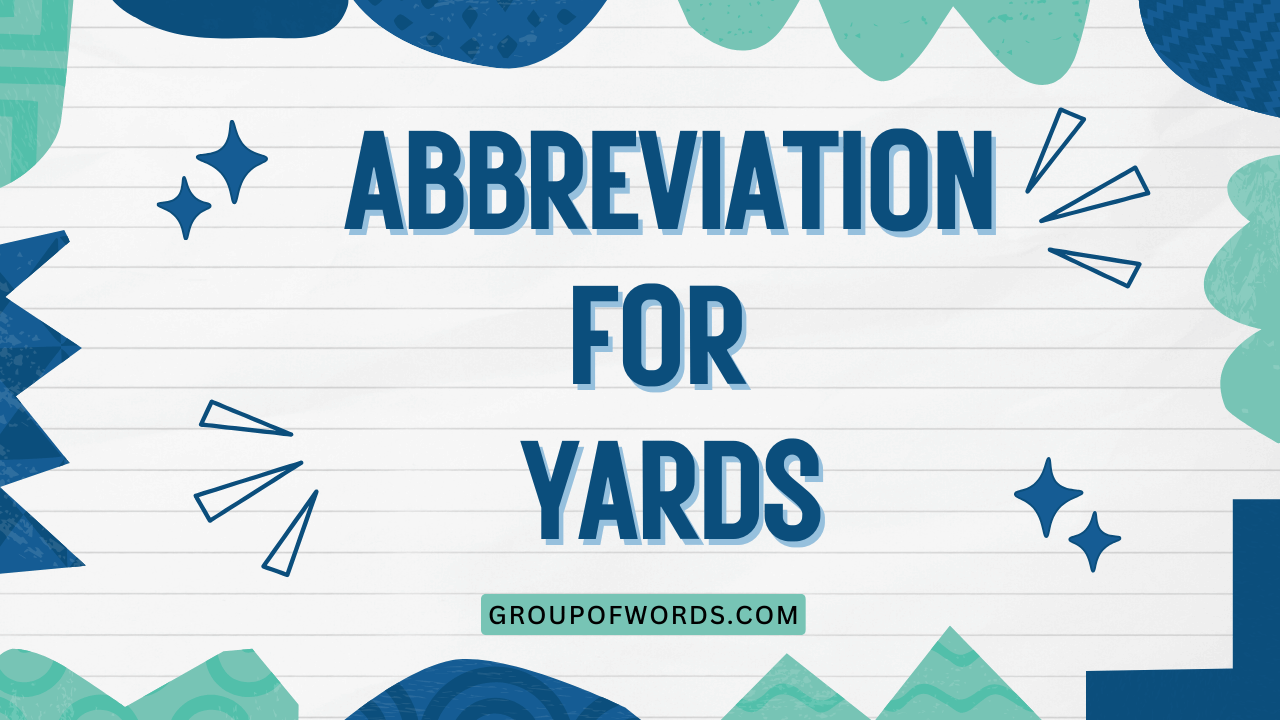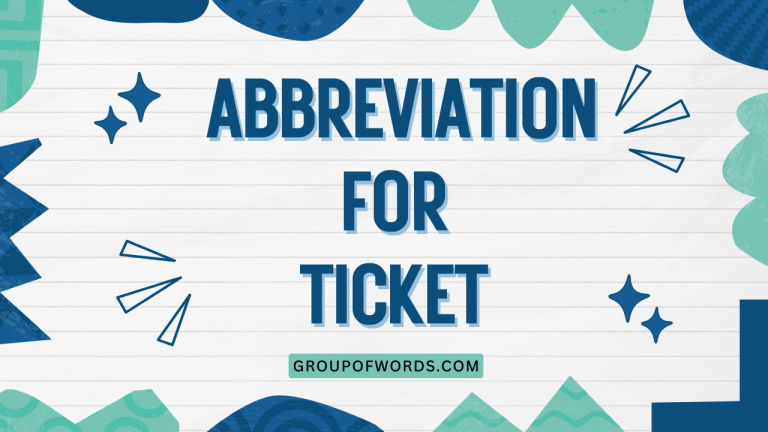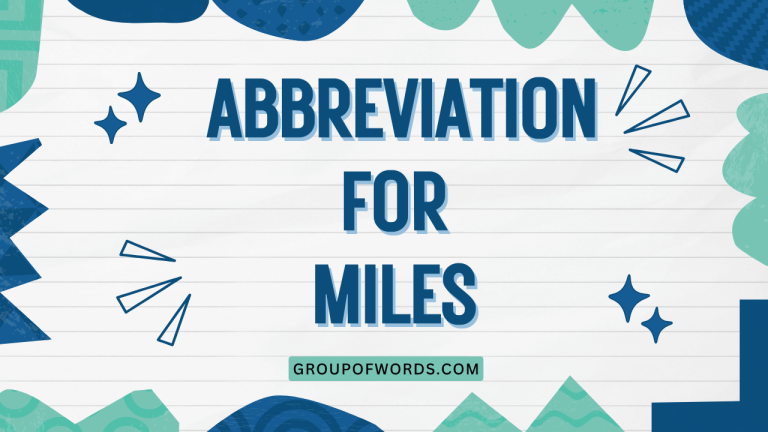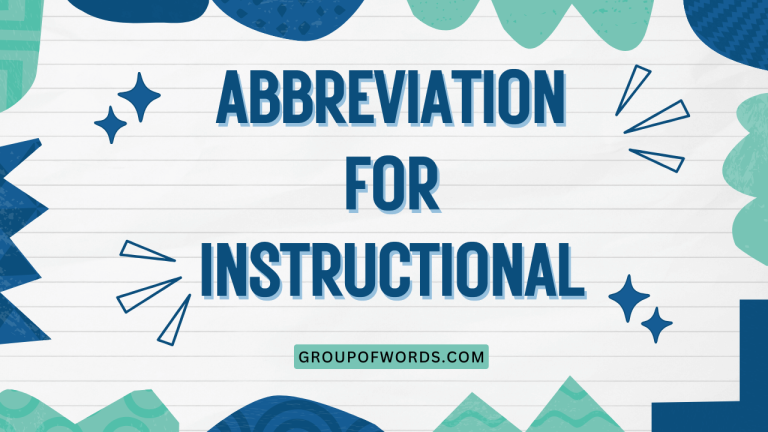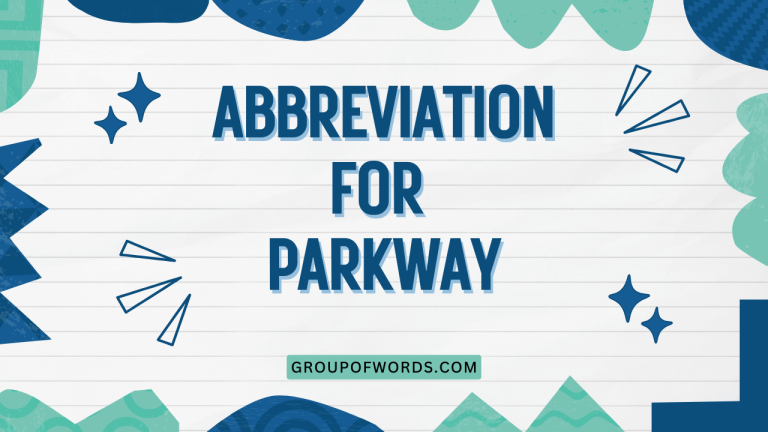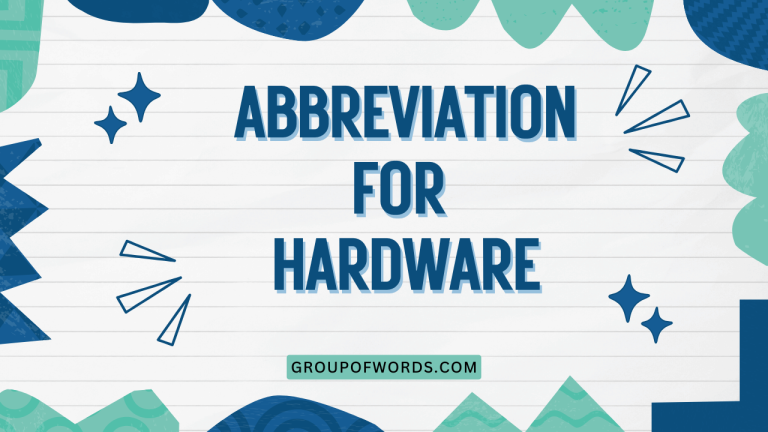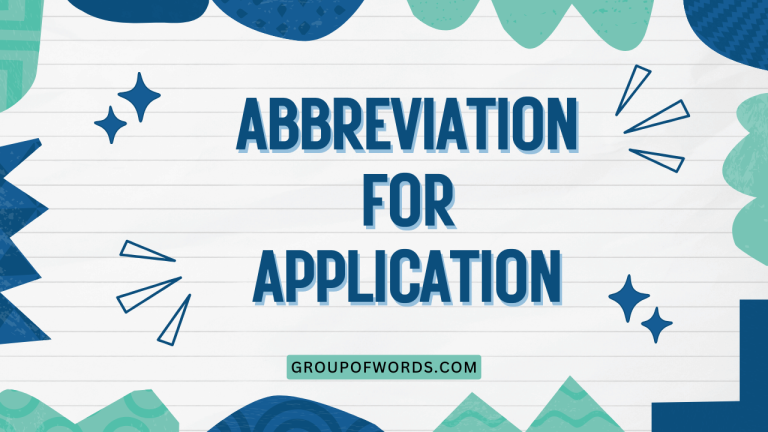Abbreviation for Yards: A Comprehensive Grammar Guide
Understanding abbreviations is crucial for clear and concise communication in English. The abbreviation for “yards,” a common unit of measurement, is often used in various contexts, from sports to gardening.
Knowing the correct abbreviation and its usage ensures accuracy and avoids confusion. This article provides a detailed guide to the abbreviation for yards, covering its definition, structural breakdown, usage rules, common mistakes, and practice exercises.
Whether you’re a student, writer, or simply someone looking to improve your English grammar, this guide will equip you with the knowledge you need to use the abbreviation for yards confidently and correctly.
This comprehensive guide is designed for learners of all levels, from beginners to advanced English speakers. We will explore the nuances of using “yd” and its plural form, delving into specific examples and scenarios to solidify your understanding.
By the end of this article, you will be able to confidently use the abbreviation for yards in various contexts, avoiding common pitfalls and ensuring clarity in your writing and communication.
Table of Contents
- Definition of Yard and Its Abbreviation
- Structural Breakdown of the Abbreviation
- Types and Categories of Usage
- Examples of Using the Abbreviation for Yards
- Usage Rules for the Abbreviation
- Common Mistakes When Using the Abbreviation
- Practice Exercises
- Advanced Topics: Historical Context and Variations
- Frequently Asked Questions
- Conclusion
Definition of Yard and Its Abbreviation
A yard is a unit of length in several different systems, including United States customary units and the British Imperial System. It is defined as 3 feet or 36 inches. The abbreviation for yard is yd. It is commonly used in contexts where space or distance is being measured, such as in sports, construction, and gardening.
The abbreviation yd is a standardized form and should be used in formal writing and technical documents. Understanding this abbreviation is essential for accurately interpreting measurements and avoiding confusion. While “yds” is sometimes used to indicate the plural of “yard,” it is generally preferred to use “yd” for both singular and plural forms in abbreviated contexts.
Structural Breakdown of the Abbreviation
The abbreviation “yd” is derived from the word “yard” by taking the first and last letters. This is a common method for forming abbreviations in English.
The abbreviation is typically written in lowercase letters. Although some style guides might suggest otherwise, the most common and widely accepted convention is to use lowercase.
The structural simplicity of “yd” makes it easy to remember and use. Unlike some abbreviations that require punctuation (e.g., “etc.”), “yd” does not need a period after it.
This streamlines its use in sentences and technical writing, contributing to clarity and efficiency.
Types and Categories of Usage
The abbreviation “yd” is versatile and appears in various contexts. Here’s a breakdown of common usage categories:
Sports
In sports, “yd” is frequently used to denote distances, particularly in American football. For example, “The team gained 10 yd on the play.” It’s also common in golf to measure distances to the hole.
Construction and Landscaping
In construction and landscaping, “yd” is used to measure lengths of materials like fabric, fencing, or piping. For instance, “We need 5 yd of fabric for the curtains.”
Gardening
Gardeners often use “yd” to measure the dimensions of garden beds, the length of rows, or the amount of material needed for a project. An example is “The garden bed is 3 yd long.”
Textiles
The textile industry uses “yd” as a standard unit for measuring fabric. For example, “The bolt contains 50 yd of cotton.”
General Measurement
In general measurements, “yd” can be used to indicate any distance measured in yards. For example, “The distance to the park is 200 yd.”
Examples of Using the Abbreviation for Yards
The following tables provide extensive examples of how to use the abbreviation “yd” in various contexts. These examples are designed to help you understand the proper usage and avoid common mistakes.
Examples in Sports
The table below illustrates the use of “yd” in a sports context, specifically American football. Notice how the abbreviation is used to denote distances gained or lost during plays.
| Example | Context |
|---|---|
| The quarterback threw the ball 25 yd downfield. | Describing a pass in football |
| The running back gained 8 yd on the carry. | Describing a running play |
| The punt traveled 45 yd. | Describing a punt |
| The team needs to gain 10 yd for a first down. | Describing the distance needed for a first down |
| The wide receiver ran a 30 yd route. | Describing the route of a wide receiver |
| He was tackled 2 yd behind the line of scrimmage. | Describing a loss of yardage |
| The penalty was 5 yd for illegal formation. | Describing a penalty |
| The kick sailed 50 yd through the air. | Describing a kickoff |
| The defense held the opponent to only 3 yd per carry. | Describing defensive performance |
| The longest pass of the game was 62 yd. | Highlighting a significant play |
| The average punt distance was 40 yd. | Providing statistical information |
| The returner advanced the ball 20 yd. | Describing a return |
| The team was penalized 15 yd for unnecessary roughness. | Describing a more severe penalty |
| The field goal was from 35 yd out. | Describing a field goal attempt |
| The safety tackled the player 1 yd from the goal line. | Describing a tackle near the goal line |
| The team drove 80 yd down the field for a touchdown. | Describing a touchdown drive |
| The pass was incomplete, resulting in no gain of yd. | Describing an incomplete pass |
| The special teams unit covered 60 yd on the kickoff. | Describing special teams performance |
| The quarterback scrambled for 12 yd. | Describing a quarterback scramble |
| The team needed only 1 yd to win the game. | Describing a critical moment in the game |
| The kicker missed the field goal from 40 yd. | Describing a missed field goal attempt |
| The receiver caught the ball 10 yd past the first down marker. | Describing a successful reception |
| The lineman was flagged for being 5 yd offsides. | Describing a penalty on a lineman |
| The team committed a holding penalty, resulting in a loss of 10 yd. | Describing a holding penalty |
Examples in Construction and Landscaping
This table provides examples of using “yd” in construction and landscaping contexts. It demonstrates how the abbreviation is used to specify lengths of materials and dimensions of spaces.
| Example | Context |
|---|---|
| We need to order 12 yd of concrete for the patio. | Ordering concrete for a construction project |
| The fence is 6 yd long. | Describing the length of a fence |
| The garden requires 3 yd of topsoil. | Estimating topsoil needs for a garden |
| The contractor estimated 20 yd of gravel for the driveway. | Estimating gravel needs for a driveway |
| I bought 5 yd of fabric for the new curtains. | Purchasing fabric for home decor |
| The trench needs to be 4 yd deep. | Specifying the depth of a trench |
| The landscaper recommended 8 yd of mulch. | Recommending mulch for landscaping |
| The roll of wire is 100 yd long. | Describing the length of a wire roll |
| The pool is 10 yd wide. | Describing the width of a pool |
| The retaining wall is 15 yd in length. | Describing the length of a retaining wall |
| The lumberyard sells wood in 8 yd lengths. | Describing the length of lumber |
| The flower bed is 2 yd wide and 5 yd long. | Describing the dimensions of a flower bed |
| We need to cover an area of 30 yd with sod. | Planning sod installation |
| The builder used 25 yd of rebar for the foundation. | Describing the use of rebar in construction |
| The pathway is 1.5 yd wide. | Describing the width of a pathway |
| The fabric store sells remnants in varying yd amounts. | Describing fabric remnants |
| The excavation required removing 100 yd of soil. | Describing soil removal during excavation |
| The installer needed 4 yd of pipe for the plumbing. | Describing the amount of pipe needed |
| The stone border is 12 yd around the garden. | Describing the length of a stone border |
| The total fencing required was 50 yd. | Describing the total fencing material needed |
| The carpenter used 3 yd of wood trim for the project. | Describing the use of wood trim |
| The concrete slab is 2 yd thick. | Describing the thickness of a concrete slab |
| The sod rolls are sold in 1 yd sections. | Describing sod roll sizes |
| The landscaper suggested adding 2 yd of compost. | Recommending compost for landscaping |
Examples in Textiles and General Measurement
The following table showcases examples of using “yd” in the textiles industry and in general measurement contexts. This demonstrates the versatility of the abbreviation across different fields.
| Example | Context |
|---|---|
| I need 3 yd of silk for the dress. | Purchasing fabric for clothing |
| The quilt requires 6 yd of cotton fabric. | Estimating fabric needs for a quilt |
| The distance to the store is approximately 2 yd. | Estimating distance |
| The ribbon is sold in 10 yd spools. | Describing ribbon packaging |
| The length of the tablecloth is 2.5 yd. | Describing the dimensions of a tablecloth |
| The fabric store has a sale on all fabrics priced per yd. | Advertising a fabric sale |
| The yarn is available in 50 yd skeins. | Describing yarn packaging |
| The tailor measured 4 yd of fabric for the suit. | Measuring fabric for tailoring |
| The curtain fabric cost $15 per yd. | Specifying fabric price |
| The roll of wallpaper is 8 yd long. | Describing wallpaper dimensions |
| The shop sells elastic in 1 yd increments. | Describing elastic sales |
| The seamstress used 2 yd of lace for the trim. | Describing lace usage in sewing |
| The tapestry measures 3 yd by 4 yd. | Describing tapestry dimensions |
| The drapery requires 10 yd of lining fabric. | Estimating lining fabric needs |
| The upholstery fabric is 54 inches wide, sold by the yd. | Describing upholstery fabric sales |
| The craft store sells felt in 1 yd squares. | Describing felt sales |
| The flag is 1 yd high and 1.5 yd wide. | Describing flag dimensions |
| The banner is 5 yd long. | Describing banner length |
| The netting is sold by the yd. | Describing netting sales |
| I need 7 yd of burlap for the project. | Purchasing burlap for a project |
| The store offers discounts on fabric over 10 yd. | Advertising fabric discounts |
| The bolt of denim contains 100 yd. | Describing a bolt of denim |
| The pattern requires 2 yd of contrasting fabric. | Specifying fabric requirements for a pattern |
| The lining added another 1 yd to the total fabric needed. | Accounting for additional fabric usage |
Usage Rules for the Abbreviation
Proper usage of “yd” involves understanding conventions regarding capitalization, pluralization, and punctuation. Here’s a breakdown of the key rules:
Capitalization
The abbreviation “yd” should always be written in lowercase, regardless of whether the full word “yard” would be capitalized (e.g., at the beginning of a sentence). This consistency ensures clarity and avoids confusion.
Pluralization
While it might seem logical to add an “s” to “yd” to indicate the plural (i.e., “yds”), the standard convention is to use “yd” for both singular and plural forms. For example, “The team gained 5 yd” is correct, not “The team gained 5 yds.”
Punctuation
The abbreviation “yd” does not require a period after it. Including a period is incorrect and should be avoided.
The absence of a period makes the abbreviation cleaner and more efficient to use.
Context
Ensure that the context makes it clear you are referring to yards as a unit of measurement. If there’s a potential for ambiguity, it may be better to use the full word “yard” or “yards” for clarity.
Consistency
Maintain consistency throughout your document or piece of writing. If you choose to use “yd” for yards, stick with it.
Avoid switching between “yd” and “yards” unless there’s a specific reason to do so.
Common Mistakes When Using the Abbreviation
Even with a clear understanding of the rules, it’s easy to make mistakes when using abbreviations. Here are some common errors to watch out for:
- Incorrect Pluralization: Using “yds” instead of “yd” for the plural form. Correct: “The fence is 10 yd long.” Incorrect: “The fence is 10 yds long.”
- Incorrect Capitalization: Capitalizing the abbreviation. Correct: “The ball traveled 50 yd.” Incorrect: “The ball traveled 50 Yd.”
- Incorrect Punctuation: Adding a period after the abbreviation. Correct: “We need 3 yd of fabric.” Incorrect: “We need 3 yd. of fabric.”
- Ambiguous Context: Using “yd” in a context where it’s unclear what it refers to. Better: “The garden bed is 5 yards long.” (Instead of: “The garden bed is 5 yd long” if the context doesn’t clearly indicate yards).
By being aware of these common mistakes, you can avoid them and ensure accuracy in your writing.
Practice Exercises
Test your understanding of the abbreviation “yd” with these practice exercises. Fill in the blanks with the correct abbreviation or correct the incorrect sentences.
Exercise 1: Fill in the Blanks
Complete the following sentences using the correct abbreviation for yards (“yd”).
| Question | Answer |
|---|---|
| The football team gained 7 ____ on the last play. | yd |
| We need to order 5 ____ of gravel for the driveway. | yd |
| The roll of fabric contains 25 ____. | yd |
| The distance to the park is about 100 ____. | yd |
| The garden bed is 3 ____ long. | yd |
| The punt went for 42 ____. | yd |
| The tailor needs 2 ____ of silk. | yd |
| The fence measures 15 ____ in length. | yd |
| The runner advanced the ball 10 ____. | yd |
| The penalty was 5 ____ for offsides. | yd |
Exercise 2: Correct the Sentences
Identify and correct the errors in the following sentences related to the abbreviation for yards.
| Question | Answer |
|---|---|
| The team gained 12 yds on the play. | The team gained 12 yd on the play. |
| We need 8 Yd of concrete. | We need 8 yd of concrete. |
| The fabric is sold by the yd.. | The fabric is sold by the yd. |
| The distance is about 200 YDS. | The distance is about 200 yd. |
| The penalty was 15 yd. for roughing the passer. | The penalty was 15 yd for roughing the passer. |
| The material needed was 3 YD. | The material needed was 3 yd. |
| The football field is 100 yds long. | The football field is 100 yd long. |
| The store sells ribbon in 5 YDS spools. | The store sells ribbon in 5 yd spools. |
| The landscaper used 6 yd. of mulch. | The landscaper used 6 yd of mulch. |
| The seamstress required 4 YD of fabric. | The seamstress required 4 yd of fabric. |
Advanced Topics: Historical Context and Variations
While the standard abbreviation for yards is “yd,” it’s interesting to note some historical context and variations in usage. The yard as a unit of measurement has ancient roots, possibly linked to the length of a person’s arm or stride.
Over time, the definition became standardized, but variations persisted in different regions.
In some older texts or less formal contexts, you might encounter variations like “y.” However, “yd” is the preferred and most widely accepted abbreviation in modern English. Understanding the historical context can provide a richer appreciation for the evolution of language and measurement systems.
Furthermore, different style guides may have slightly different recommendations for abbreviations in general. While the rules outlined in this article align with common practice, it’s always a good idea to consult the specific style guide required for a particular publication or project.
Frequently Asked Questions
Here are some frequently asked questions about the abbreviation for yards:
- Is it correct to use “yds” for the plural of yard?
No, it is generally not correct. The standard convention is to use “yd” for both singular and plural forms. For example, “The team gained 5 yd,” not “The team gained 5 yds.”
- Should I capitalize the abbreviation “yd”?
No, the abbreviation “yd” should always be written in lowercase letters, regardless of the context or sentence structure.
- Do I need to put a period after “yd”?
No, the abbreviation “yd” does not require a period after it. Adding a period is incorrect and should be avoided.
- Is it ever appropriate to use the full word “yards” instead of the abbreviation?
Yes, in contexts where clarity is paramount or where the abbreviation might be ambiguous, it’s best to use the full word “yards.” Also, in less technical or informal writing, using the full word can improve readability.
- Are there any style guides that recommend a different abbreviation for yards?
While “yd” is the most widely accepted abbreviation, some style guides might have specific recommendations. It’s always a good idea to consult the relevant style guide for a particular publication or project.
- Can I use “yd” in all types of writing?
Yes, “yd” is generally acceptable in most types of writing, especially technical, scientific, or sports-related content. However, in very formal or literary writing, using the full word “yards” might be more appropriate.
- What if I’m unsure whether my audience will understand the abbreviation “yd”?
If you’re writing for an audience that may not be familiar with the abbreviation, it’s best to spell out the word “yards” the first time you use it, followed by the abbreviation in parentheses. For example: “The football field is 100 yards (yd) long.” After that, you can use “yd” freely.
- Why is “yd” the accepted abbreviation if it only uses the first and last letter?
While unusual, “yd” likely became the standard abbreviation through historical usage and convention. The choice of letters in abbreviations often reflects a balance between brevity, clarity, and established practice. There isn’t a strict rule dictating how abbreviations are formed; common usage and acceptance are key factors.
Conclusion
Mastering the abbreviation for yards, “yd,” is a fundamental aspect of English grammar and usage. This guide has provided a comprehensive overview of its definition, structural breakdown, usage rules, common mistakes, and variations.
By understanding these concepts and practicing the exercises, you can confidently use “yd” in your writing and communication.
Remember to always use lowercase letters, avoid adding a period, and use “yd” for both singular and plural forms. By avoiding common mistakes and maintaining consistency, you’ll ensure clarity and accuracy in your writing.
Continue to practice and apply these rules in different contexts to solidify your understanding and enhance your overall English proficiency. With these tools, you are well-equipped to handle measurements in your writing effectively.
